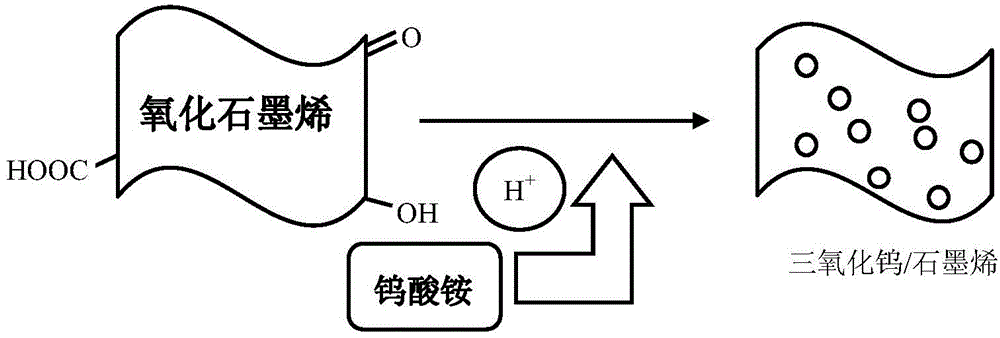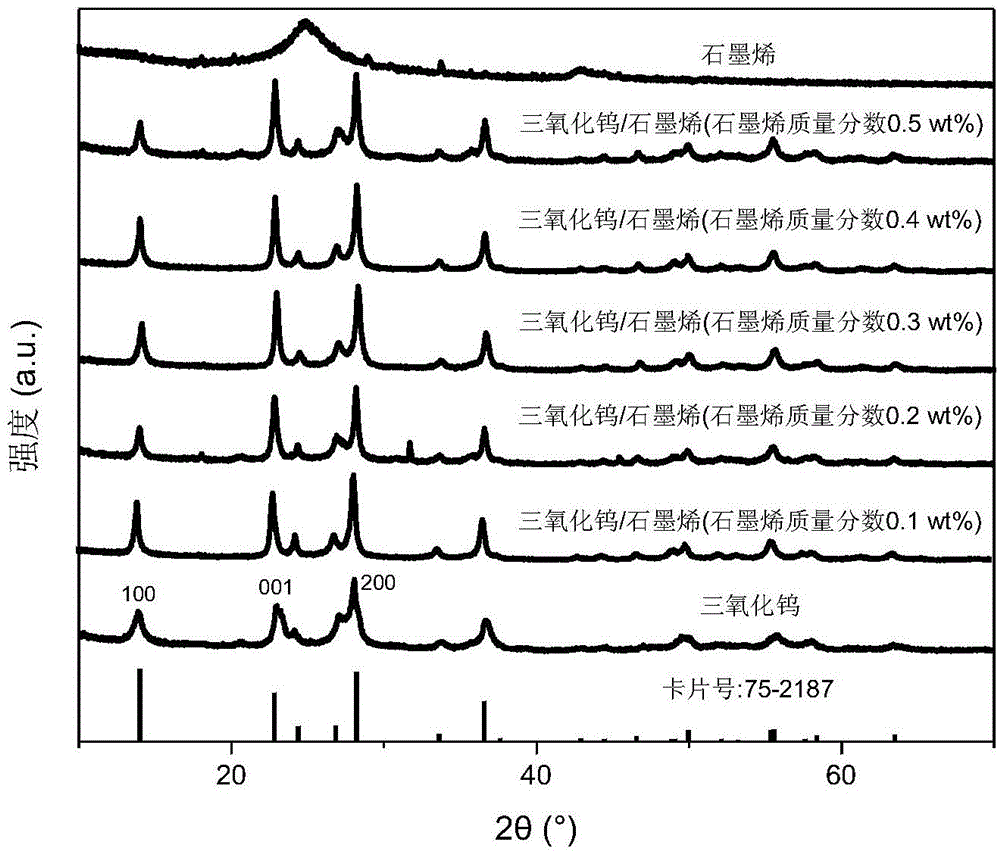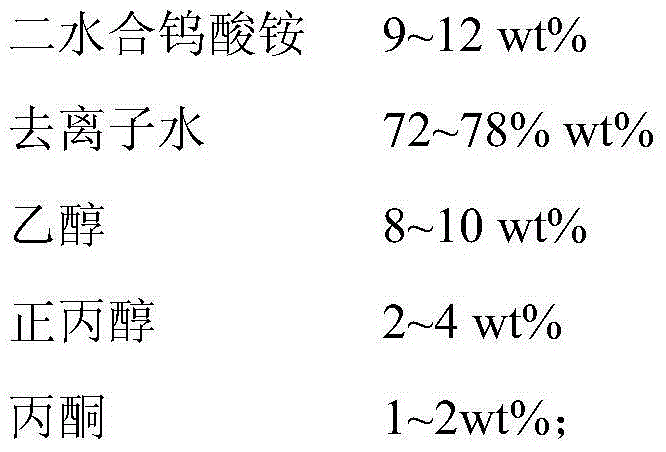Visible-light catalyst and preparation method and application thereof
A catalyst and visible light technology, applied in the field of photocatalysis, can solve the problems of poor semiconductor stability, inability to release hydrogen and oxygen at the same time, failure, etc., and achieve the effect of improving quantum efficiency
- Summary
- Abstract
- Description
- Claims
- Application Information
AI Technical Summary
Problems solved by technology
Method used
Image
Examples
Embodiment 1
[0018] Example 1: WO 3 / Graphene Visible Light Catalytic Degradation of Oxidative Wastewater
[0019] Preparation of WO with 0.2% graphene 3 catalyst:
[0020] 1) Weigh 0.0093g graphene oxide (GO) powder prepared by Hummer method, and disperse in
[0021] 50mL of deionized water, ultrasonic for 1h to fully peel off, after standing still, take the supernatant for later use;
[0022] 2) Weigh 6.4g (NH 4 ) 2 WO 4 2H 2 O, heated in a water bath at 60°C and dissolved in 50mL of deionized water, added 6mL of absolute ethanol, 2mL of n-propanol, and 1mL of acetone to fully mix to form a microemulsion, and added concentrated HCl drop by drop under vigorous stirring. Until no more precipitation occurs, slowly add the solution obtained in 1) to the mixed solution, add dilute HCl dropwise to adjust the pH value to 1.0, continue stirring for 30min, and transfer to 150mL
[0023] In a high-temperature hydrothermal reaction kettle, keep warm at 120°C for 24 hours, and cool down to ...
Embodiment 2
[0027] Example 2 WO 3 / Graphene Visible Light Catalytic Degradation of Industrial Wastewater
[0028] Preparation of WO with 0.3% graphene 3 catalyst:
[0029] 1) Weigh 0.0139g of graphene oxide (GO) powder prepared by the improved Hummer method, disperse it in 20mL of deionized water, ultrasonically peel it off for 1h, and take the supernatant after standing for use;
[0030] 2) Weigh 4.8g (NH 4 ) 2 WO 4 2H 2 O, dissolve in 30mL of deionized water by heating in a water bath at 60°C, add 4mL of absolute ethanol, 1.5mL of n-propanol, and 0.5mL of acetone to fully mix to form a microemulsion, add concentrated HCl drop by drop under vigorous stirring, first precipitate, stir and precipitate Dissolve until no more precipitation occurs, slowly add the solution obtained in 1) into the mixed solution, add a certain amount of dilute HCl dropwise to adjust the pH value to 0.5, continue stirring for 20min, transfer to a 100mL high-temperature hydrothermal reaction kettle, keep it...
Embodiment 3
[0034] Example 3: WO 3 / Graphene Visible Light Catalytic Decomposition of Water to Produce Oxygen
[0035] Preparation of WO containing 0.4% graphene 3 catalyst:
[0036] 1) Weigh 0.0186g of graphene oxide (GO) powder prepared by the improved Hummer method, disperse it in 50mL of deionized water, ultrasonically peel it off for 1h, and take the supernatant after standing for use;
[0037] 2) Weigh 6.4g (NH 4 ) 2 WO 4 2H 2 O, heated in a water bath at 60°C and dissolved in 50mL of deionized water, added 6mL of absolute ethanol, 2mL of n-propanol, and 1mL of acetone to form a microemulsion, and added concentrated HCl drop by drop under vigorous stirring. Until no more precipitation occurs, slowly add the solution obtained in 1) into the mixed solution, add dilute HCl dropwise to adjust the pH value to 1.5, continue stirring for 30 minutes, transfer to a 150mL high-temperature hydrothermal reaction kettle, keep it at 160°C for 72 hours, and naturally cool to room temperatur...
PUM
 Login to View More
Login to View More Abstract
Description
Claims
Application Information
 Login to View More
Login to View More - R&D Engineer
- R&D Manager
- IP Professional
- Industry Leading Data Capabilities
- Powerful AI technology
- Patent DNA Extraction
Browse by: Latest US Patents, China's latest patents, Technical Efficacy Thesaurus, Application Domain, Technology Topic, Popular Technical Reports.
© 2024 PatSnap. All rights reserved.Legal|Privacy policy|Modern Slavery Act Transparency Statement|Sitemap|About US| Contact US: help@patsnap.com










